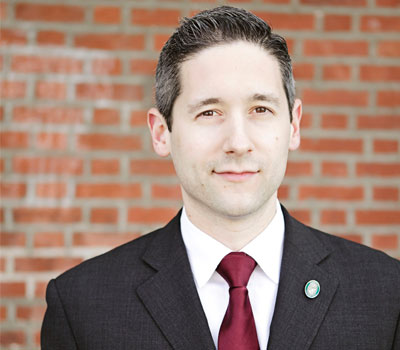Charles Puglia fell into the restaurant business in his twenties and hasn’t looked back. He made his way to New York Columbus Circle US New York Puglia
does all the wine buying at the restaurant, where he holds to a focus on French wines, while building the presence of US wines as well.


Two sauvignon blancs—Vacheron Sancerre and Guy Baudin Pouilly-Fumé— top your ten most popular wines.
Sancerre has become a wine that people call for with the same regularity as they would their favorite brand of vodka. They might not even know all of the producers, but they know Sancerre is delicious. It was really important for us, if we were going to put a sauvignon blanc on by the glass, that we highlight a top producer. While I love some of the producers that are known for high quality—like Dagueneau, the Cotats, Vatan—Vacheron is my all-time favorite producer in Sancerre. Vacheron tends to be the highest seller in terms of wine by the bottle on our list. I think that’s also because it sits at a really nice price point [$120]; it’s something that we offer by the glass as well. It’s the most popular wine in the restaurant if you total all of the glasses we sell as well as the same selection by the bottle; we go through ten cases a month, at least, maybe 15. If you take a look at the bottle list, you’ll see a full offering from Vacheron. I’m a fan.
Baudin is a delicious Pouilly-Fumé. I think people often forget about Pouilly-Fumé being on par in terms of quality with Sancerre, despite Dagueneau’s efforts. I think you can get pretty good values from Pouilly-Fumé still. The Baudin is just delicious. Totally correct. Totally classic and typical sauvignon blanc from the Loire Valley. Not too racy, but also not too fat and generous. It sits at a price point under $70, which is very attractive for guests who are just looking for something easy and fresh and not too pricy.
You list two wines from St-Joseph—Cuilleron and Guy Farge—among your ten best selling bottles. Both are $85 on the list. When would you recommend one over the other?
The Cuilleron St-Joseph tends to be a little plush and a little more giving in terms of style. He’s really a white wine producer and I feel like the red wines are often made like the white wines. Cuilleron has specialized in Condrieu, where his wines are plush and generous and juicy without being too modern or too fruit-full. Guy Farge’s St-Joseph tends to have a little bit more of that tougher, old-school kind of Rhône character, where it kind of bites back at you a little bit.
I’d probably go with either wine for the venison, but if we were going to pair with the filet, which usually is a pretty lean cut and the preparation adds a lot of richness, with bone marrow and a rich Bordelaise sauce, I’d steer towards the Guy Farge. Those wines tend to be a little bit better with richer foods. Steak houses often rely on cabernet from the United States, but I’ve found those wines tend to not be really good with steak because it’s so much richness on richness. Guy Farge has a leaner and fresher style, I would steer towards that as a better counterpoint.
We do have some American wines—there are a lot of great producers that are making more restrained styles of wine and I think that goes better with our food and what we are trying to do—syrah, for example, from the cooler reaches of California, Sonoma Coast or some Central Coast seaside appellations.
And we just recently put some Washington wine on the list. Right now, it’s Reynvaan, who’s wines are pretty spectacular. They’re making syrah-based wines from Walla Walla and they still manage to not make 16 percent alcohol monsters. The wines are restrained and savory, really phenomenal, beautifully structured syrah. Fully ripe—physiologically ripe—and very concentrated. That’s an exciting place for me: cool-climate California and Washington State syrah.
And what’s exciting you in France?
Right now, it’s the wines coming from the southwest—a couple that we already started adding to the list. Elian Da Ros, who’s based out of Côtes du Marmandais—I just discovered those wines, and those are pretty phenomenal. I’d like to give wines from this area a little more play on the list.
If you were dining at Le Coucou tonight, what would you be ordering?
I think that we may have sold out of the Zind-Humbrecht Pinot Gris Calcaire on the list, but really one of my favorite pairings on the list would be a rich Alsace white wine with the duck choucroute—the duck for two. Everybody wants to pair Burgundy with that dish, but it’s classic Alsatian and rich white wine really goes best with that—a pinot gris or a really rich riesling. An alternative would be the monkfish. That with a really fantastic Burgundy will absolutely blow your mind. It’s the most delicious thing in the universe. White Burgundy, you couldn’t go wrong. I’d want something that is really tasty, but not outrageously expensive, and the richer the better with that dish. But, also, you could go for some big, flashy Montrachet. I wouldn’t be afraid about having a little bit of new oak with that dish. We recently just tasted the Baron Thénard Montrachet, the 2012 vintage, which was pretty rich, as you could imagine, but just singing. I’d drink that with the monkfish dish, and I would be really, really happy. White Burgundy with that dish would knock your socks off.
A recent graduate of the University of Pennsylvania, Allison Bart worked a harvest at Soter Vineyards in Oregon’s Willamette Valley, then worked in retail at Frankly Wines in NYC. Having spent six months in Melbourne in 2013, she developed an interest in Australian wines. Allison is currently the Culture & Events Manager at SevenFifty.















